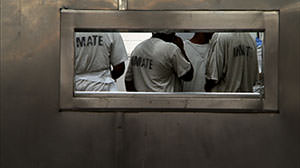Prison and Poverty for All: The Future We Live In
A new documentary about prison and the drug war makes the science fiction dystopias of "Looper" and "Dredd 3D" feel disturbingly plausible.
It’s too bad Eugene Jarecki already used the title “Why We Fight” for his breakout 2006 documentary about war profiteering, because he could so perfectly have applied it to his newest movie, “The House I Live In.” It’s an examination of the drug war that does more than testify against America’s overtly racist drug laws or the justice-industrial complex of private prisons and the overtime-hungry cops who help fill them. The documentary, which won this year’s Sundance Grand Jury prize and will arrive in a handful of theaters this month, dares to suggest that human beings have a thing for destroying one another.
Jarecki makes a very compelling argument with the help of many interview subjects, but none more important than David Simon, a former crime reporter who created “The Wire,” a beloved TV show that may itself be confused for a documentary on the drug war. Simon spent a lot of time reporting on and dramatizing this conflict and its exhausted combatants, and he, along with historian Richard Lawrence Miller, ultimately expresses the documentary’s hidden thesis with brute force. The drug war is, they say, a “holocaust in slow motion.” The director reveals his climax like the denouement of a great mystery. It’s his Keyser Söze moment, and I won’t spoil it by elaborating further.
Long before then, Jarecki presents many perspectives of what he calls “a tragically misguided system that preys upon those least fortunate among us to sustain itself.” From the drug dealers to the judge, most of the director’s subjects agree that the system isn’t good for much, other than the mass transfer of poor people to jail.
Jarecki constructs the documentary around the life of his childhood nanny, whose family has struggled with drugs. He is curious about the racial bias of her misfortune — she is black, he is not — and in exploration he finds that “whatever damage drugs do to people has been made far worse by the laws America has enacted to stop drugs.”
This is because war is the wrong metaphor for what is ultimately a health, economic and social crisis. The ghetto, as depicted in the film, is a farm for police to harvest human overtime slips. As is well captured on “The Wire,” the system makes sport of the downtrodden wretches caught engaging in the only economic activity available to them. Judges, forced by shortsighted laws to pronounce sentences that are, at a minimum, draconian, wrestle with their guilt. Even the prison guard, who acknowledges that his town’s survival is dependent on the system, condemns it.
Missing from all this is the literal war — the often bloody fight funded by the United States to take place elsewhere in the world. At a screening this summer, we were joined by Jarecki, along with Los Angeles County District Attorney Steve Cooley.
Someone in the audience criticized the director for leaving out the tens of thousands who have been killed these last few years in Mexico. Jarecki explained that he believed that tragedy deserved an entire documentary by itself. Others stood to ask why their particular fixation was not better represented. Why not more on the science of addiction, one person asked, while another, who sounded suspiciously like a pothead, pressed the subject of medical marijuana and prohibition. But “The House I Live In” is well served by its limitations. It would take a Ken Burns epic to chronicle every facet of the war on drugs. Instead, Jarecki returns again and again to the rot at the core of the war: our inhumanity to one another. Whether we’re boxing the less fortunate into ghettos or prisons, some social defect allows us to look away.
Ultimately it’s the guards and cops and judges — who are prevented by their occupations from turning a blind eye — who make the best witnesses in Jarecki’s film. For the rest of us, it’s too easy to not notice that we house one-quarter of the world’s prison population.
Much of “The House I Live In” feels like a story I’ve already read, but there are moments of genius that are riveting. The editing as much as the direction is to be thanked for those graceful scenes that tie together a sprawling, meandering epic of a documentary. Jarecki’s fairness is deliberate and maybe even a bit self-conscious, but it helps when the audience is asked to think of popular anti-drug programs as a system designed to, as Simon bluntly puts it, “kill the poor.”
There is one argument that seems half-baked and I wish Jarecki had had the time to go into greater depth. The movie suggests that even the harshest drugs are blown way out of proportion, just as “Reefer Madness” made the benign high of marijuana appear murderous. So, too, with crack and crystal meth, we are told. I’m not so sure.
Cooley, although utterly tone-deaf and resistant to much of the documentary screened that night, was there to remind us that the city of Los Angeles is enjoying record low crime rates. I checked. In 2011, it had fewer than 300 murders. In the 1990s, during the crack epidemic that “The House I Live In” suggests was over-hyped, the number hovered around 1,000 a year.
Don’t let that quibble get between you and this documentary. If “The House I Live In” isn’t one of the best pictures of the year, it’s at least one of the most important.
***
Coincidental to the limited release of “The House I Live In,” two new science fiction thrillers have also made their way into theaters.
One would think “Dredd 3D,” an action movie based on the 1970s comic and a character, Judge Dredd, last acted by Sylvester Stallone, would have nothing to do with “The House I Live In.” But almost the entire film takes place inside a massive, post-apocalyptic housing project that contains more than 70,000 people and looks and feels like something out of “The Wire: 2100.” Indeed, Wood Harris, a key actor in “The Wire,” reprises his talents playing a drug-dealing baddie in the film.
I would be shocked if screenwriter Alex Garland, who wrote the highly entertaining novel “The Beach” and reinvented zombies as the scribe of director Danny Boyle’s “28 Days Later,” was not in some way influenced by “The Wire” or the drug war itself.
The film takes place in a future where police, judges and executioners are all the same thing, conscious that their duty-bound efforts to detain and punish the lawbreakers living in the megaslums that remain of northeastern America have little hope of turning the tide against the drug trade. Karl Urban, who plays Dredd and whose face is never revealed, reminded me of some of the worn out cops in Jarecki’s documentary, admitting freely that there is little the “Hall of Justice” can do to actually keep people safe. Furthermore, the film often depicts the police or “judges” as a destructive threat to the communities they are meant to protect, just as is argued in Jarecki’s real-life tale of woe. It makes for an interesting double feature.
Another film just making its release is “Looper,” a brain twisting mashup of Dashiell Hammett, Philip K. Dick and William Gibson. It is the best science fiction movie to come out since “Children of Men” in 2006 and, although it requires a participatory imagination, it does not put one through the same kind of mental strain found in “Inception,” which nearly gave me a seizure trying to keep up.
What has it got to do with “The House I Live In”? Not much, except that the future painted in “Looper” feels uncomfortably plausible after watching Jarecki’s documentary, or reading a Chris Hedges column, for that matter.
These are three excellent films all worth seeing, but I suggest taking them in doses, perhaps with a frivolous romantic comedy in between. We live in frightening and difficult times and entertainment, mirroring documentary, is projecting those anxieties with an alarming sense of the inevitable.
Your support matters…Independent journalism is under threat and overshadowed by heavily funded mainstream media.
You can help level the playing field. Become a member.
Your tax-deductible contribution keeps us digging beneath the headlines to give you thought-provoking, investigative reporting and analysis that unearths what's really happening- without compromise.
Give today to support our courageous, independent journalists.






You need to be a supporter to comment.
There are currently no responses to this article.
Be the first to respond.